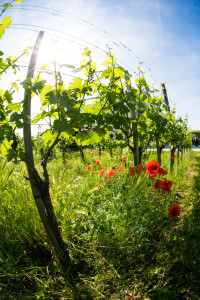The Austrian Wine Marketing Board has just made a big announcement: four new grape varieties have been added to the list of “approved” varieties for use in the PGI and PDO wines of Austria! This makes for a total of 40 approved grapes, including 14 red and 26 white varieties, all of which will be valid for use as of the 2018 vintage. All of the newly-approved grape varieties are white.
Here is a bit more information on these grapes:
Blütenmuskateller: Blütenmuskateller is a hybrid white grape variety created in Russia (then the USSR) in 1947. It is a somewhat complicated combination of Severny (itself a vinifera X amurensis hybrid) crossed with Muscat Blanc à Petits Grains. In Russia, the grape was known as Cvetocny (Cvetochny). The grape is renowned for its ability to achieve high sugar content and is often used in sweet wines. Wines based on Blütenmuskateller tend to show “grape-y” Muscat-like notes in addition to aromas of tropical fruit, flowers, perfume, and sweet spices such as nutmeg.
Goldmuskateller: Goldmuskateller is a golden-berried version of Muscat believed to be native to northern Italy—where it is known as Moscato Giallo and used in some of the DOC wines of Trentino and Alto Adige. It is most likely a descendant of Muscat Blanc à Petits Grains. Goldmuskateller is often used to produce sweet wines, but dry wines can be delightful as well. Goldmuskateller-based wines tend to show the rich fruit, “grape-like” aromas common to Muscat as well a deep yellow-gold color and musky-spicy-floral aromas and flavors.
Muscaris: Muscaris is a German-bred hybrid grape created via the combining of Solaris (a white-skinned hybrid of Merzling and Geisenheim) X Muskateller (Muscat). Muscaris grapes tend to develop high levels of sugar and acidity, making them a good choice for sparkling wines. Typical aromas include lemon, orange, tangerine, and “musky perfume.”
Souvignier Gris: Souvignier Gris is a pink-skinned, German-bred hybrid grape created via the union of Cabernet Sauvignon and Bronner (a white-skinned hybrid of Merzling and Geisenheim). Souvignier Gris is known for high must weights and somewhat neutral fruity-floral aromas reminiscent of Pinot Blanc.
Three of the new grape varieties—Blütenmuskateller, Muscaris, and Souvignier Gris—are considered to be particularly resistant to fungal diseases such as powdery mildew and downy mildew. Such grapes are known as “PIWI” varieties (Pi = Pilz [fungus]; wi = widerstandsfähig [resistant]) and are well-suited to organic and sustainable viticulture.
Wine students might find it surprising that the list of newly-approved grape varieties includes hybrids. However, Austria has included hybrids (specifically Ráthay and Roesler) on its list of approved varieties for several years.
Click here for an updated list of: The Austria 40-wine grapes approved for use in Austria
References/for more information:
- https://www.austrianwine.com/press-multimedia/news/news-2018/news/article/austrian-qualitaetswein-four-new-grape-varieties/
- https://glossary.wein-plus.eu/bluetenmuskateller
- https://sibbus.com/en/variety-descriptions/white-wine-varieties/souvignier-gris.html
- https://sibbus.com/en/variety-descriptions/white-wine-varieties/muscaris.html
- https://en.wikipedia.org/wiki/Moscato_Giallo
- Robinson, Jancis, Julia Harding and José Vouillamoz: Wine Grapes. New York, 2012: Harper Collins Publishers


